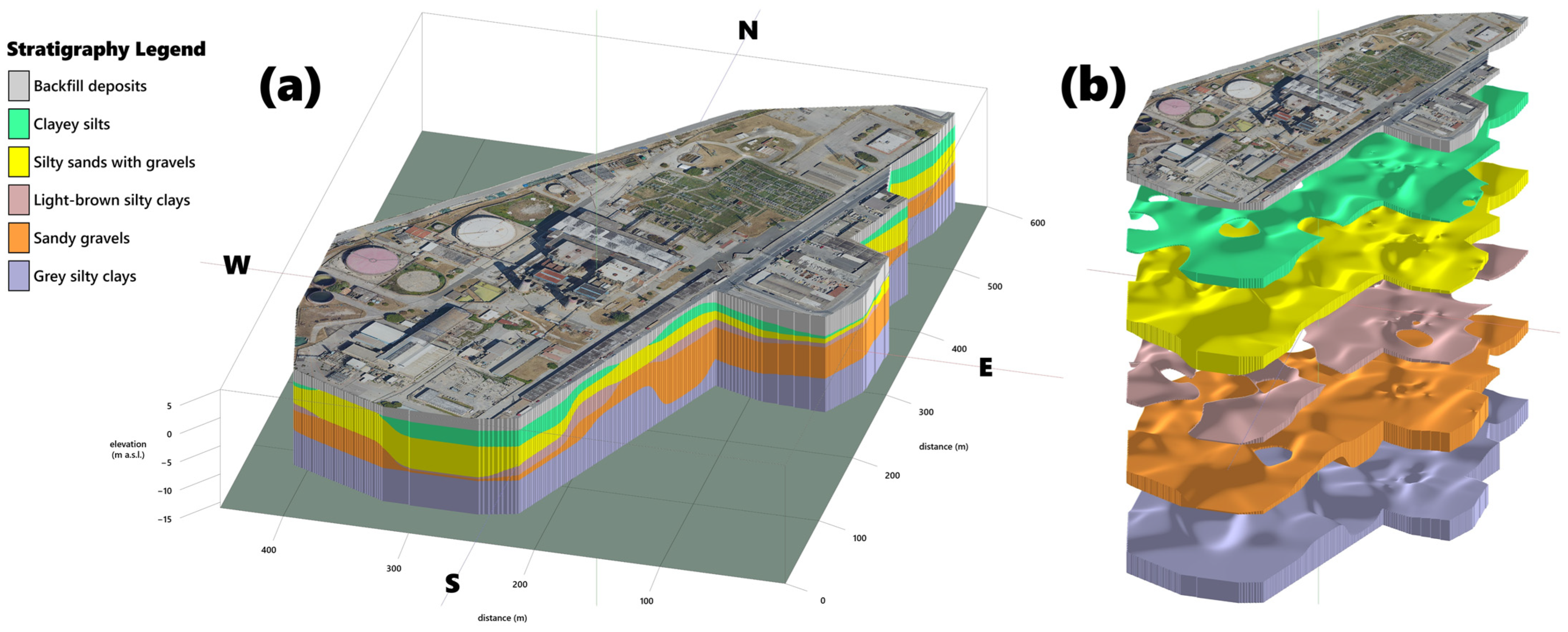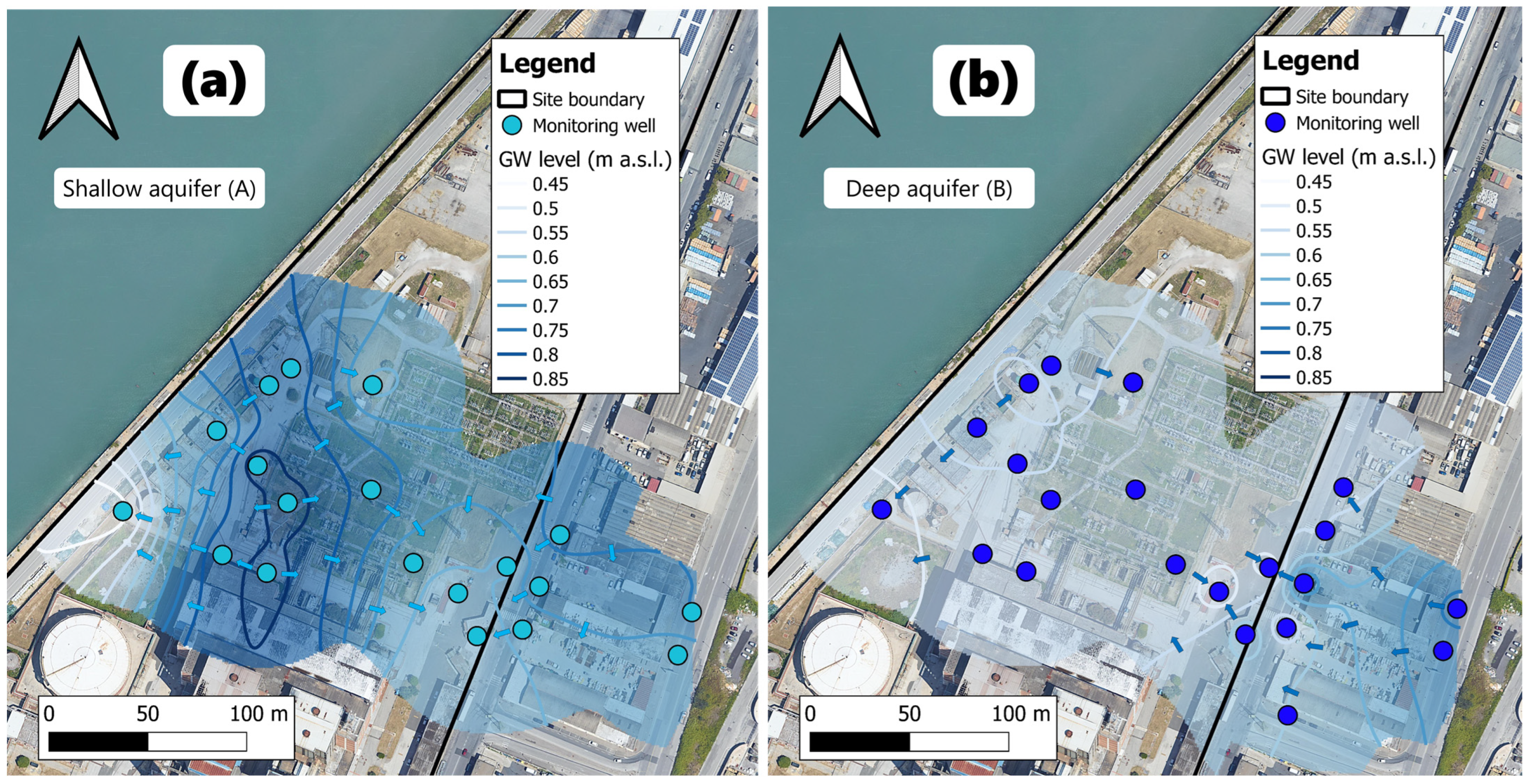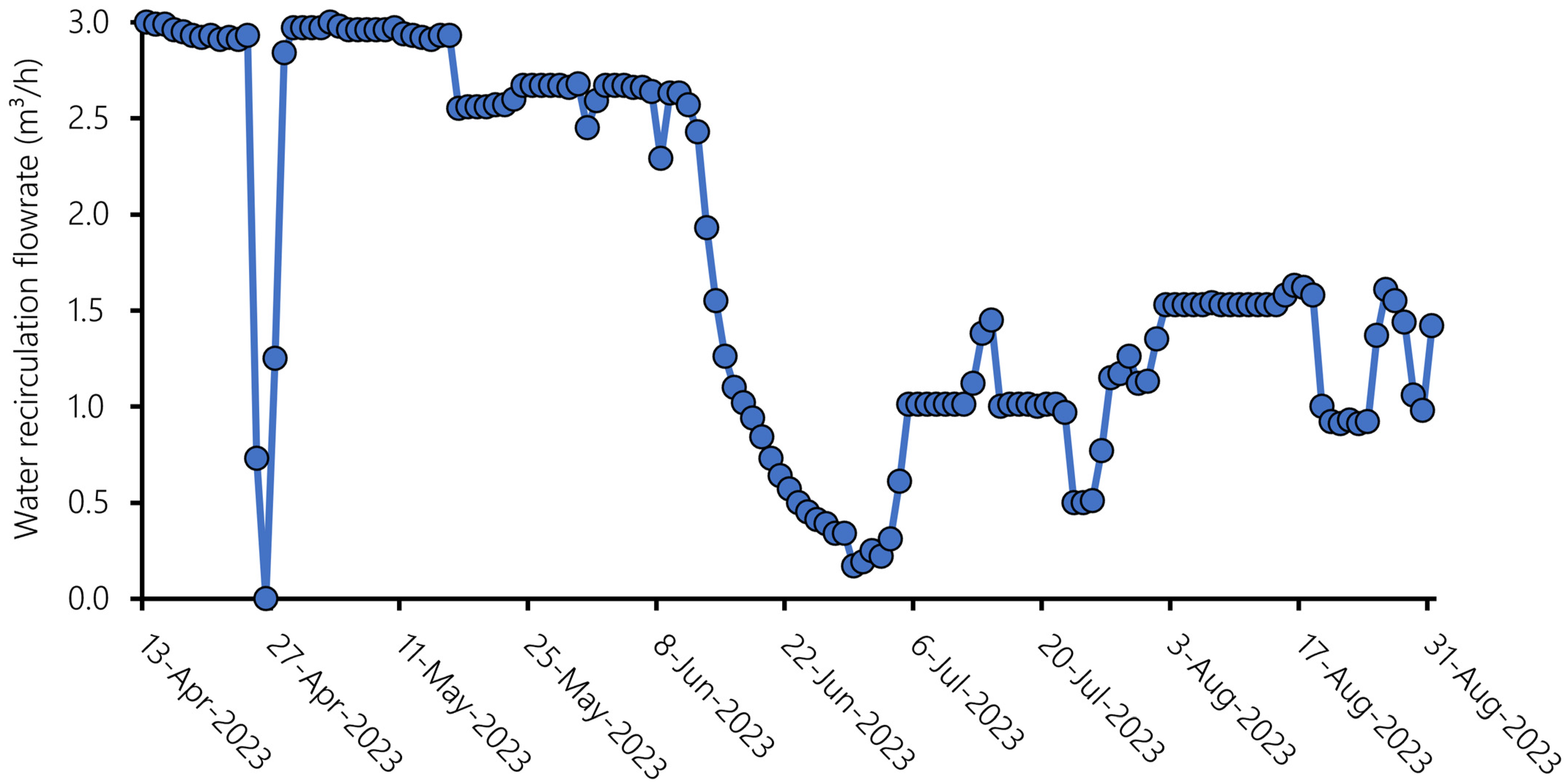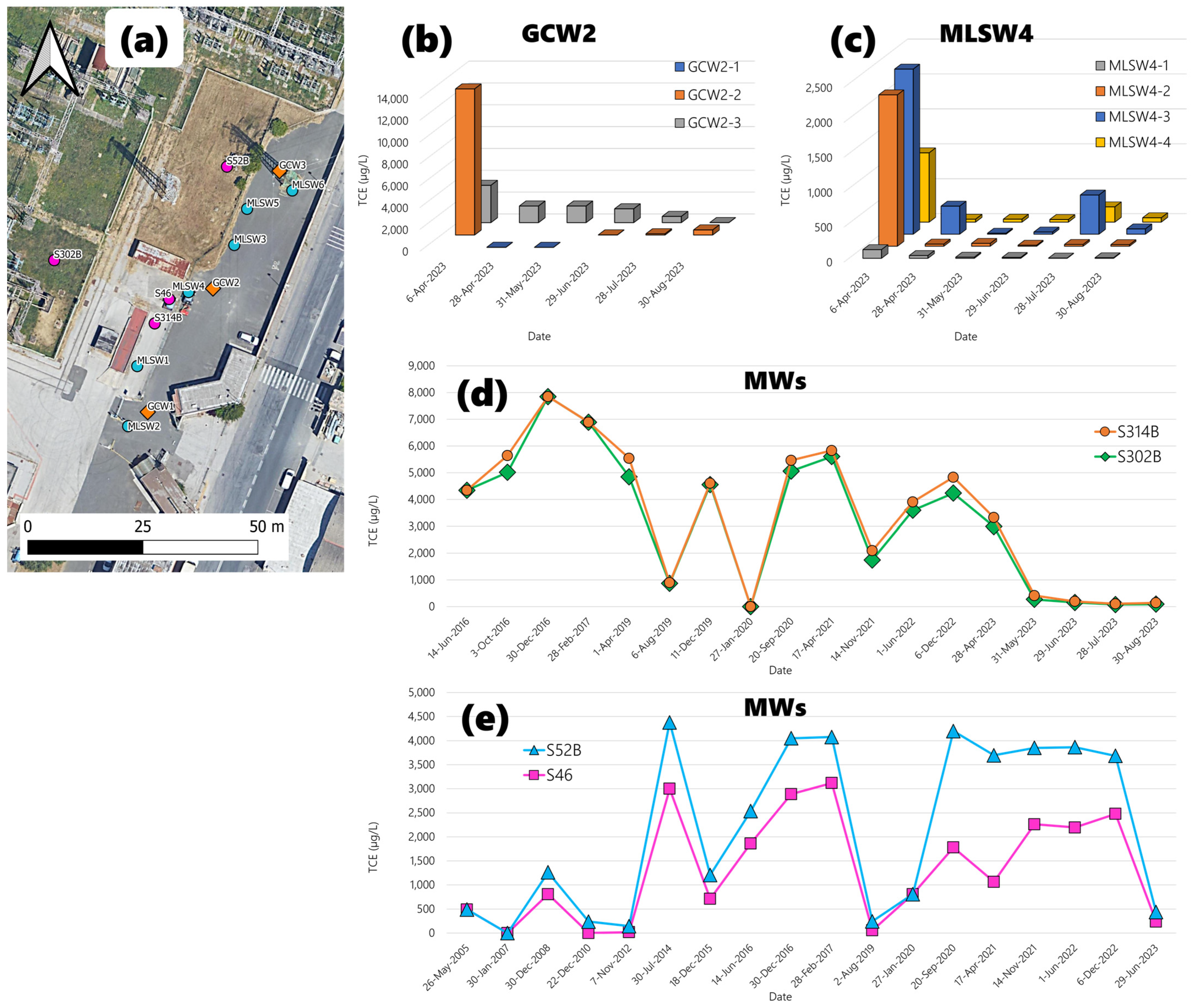3D GeoRemediation: A Digital Hydrogeophysical–Chemical Clone and Virtual Hydraulic Barrier with Groundwater Circulation Wells (GCWs) for Groundwater Remediation
Abstract
1. Introduction
1.1. Understanding and Addressing Groundwater Contamination by Chlorinated Solvents
1.2. Reimagining Contaminated Site Characterization: Innovative Approaches to Advanced Conceptual Modeling
1.3. Remediation Strategies for Groundwater Contaminated with DNAPL: A Spotlight on GCW
1.4. Case Study: The First Virtual Hydraulic Barrier for Intercepting a Contamination Plume
2. Materials and Methods
2.1. Reconstruction of Conceptual Site Model
2.2. Remediation Strategy Configuration
3. Results and Discussion
3.1. Geological and Hydrogeological Framework
- Clayey-silty deposit at depths ranging from 2 to 4 m from the ground level, which locally confines the groundwater circulation hosted in the underlying sediments,
- A horizon with an average thickness of 2.6 m, consisting of sandy-clayey deposits with gravels that form a shallow aquifer (A) and exhibit an average hydraulic conductivity of approximately 2 × 10−5 m/s,
- Light brown silty-clayey deposits at depths ranging from 6.5 to 8 m, revealing a spatially discontinuous distribution across the study area and hydraulically separating the shallow aquifer from the circulation of deeper groundwater,
- Compact gravel with sandy matrix, with an average thickness of 4 m and hydraulic conductivity of about 9 × 10−4 m/s, forming a deep aquifer (B),
- A low-permeability layer consisting of grey silty clays, encountered at a depth of approximately 12 m, acting as an aquiclude.
3.2. Identification of the Contamination Source and Reconstruction of Pollution Dynamics
3.3. Remediation Strategy Design and Decontamination Evidence
4. Conclusions
Supplementary Materials
Author Contributions
Funding
Institutional Review Board Statement
Informed Consent Statement
Data Availability Statement
Acknowledgments
Conflicts of Interest
References
- He, H.; Li, Y.; Shen, R.; Shim, H.; Zeng, Y.; Zhao, S.; Lu, Q.; Mai, B.; Wang, S. Environmental occurrence and remediation of emerging organohalides: A review. Environ. Pollut. 2021, 290, 118060. [Google Scholar] [CrossRef] [PubMed]
- Newell, C.J.; Cowie, I.; McGuire, T.M.; McNab, W.W. Multiyear temporal changes in chlorinated solvent concentrations at 23 monitored natural attenuation sites. J. Environ. Eng. 2006, 132, 653–663. [Google Scholar] [CrossRef]
- Rivett, M.O.; Turner, R.J.; Murcott, P.G.; Cuthbert, M.O. The legacy of chlorinated solvents in the Birmingham aquifer, UK: Observations spanning three decades and the challenge of future urban groundwater development. J. Contam. Hydrol. 2012, 140–141, 107–123. [Google Scholar] [CrossRef] [PubMed]
- Moran, M.J.; Zogorski, J.S.; Squillace, P.J. Chlorinated solvents in groundwater of the United States. J. Environ. Sci. 2007, 41, 74–81. [Google Scholar] [CrossRef] [PubMed]
- Walaszek, M.; Cary, L.; Billon, G.; Blessing, M.; Bouvet-Swialkowski, A.; George, M.; Criquet, J.; Mossmann, J.R. Dynamics of chlorinated aliphatic hydrocarbons in the Chalk aquifer of northern France. Sci. Total Environ. 2021, 757, 143742. [Google Scholar] [CrossRef]
- Kueper, B.H.; Stroo, H.F.; Vogel, C.M.; Ward, C.H. Chlorinated Solvent Source Zone Remediation; Springer: New York, NY, USA, 2014. [Google Scholar]
- Brusseau, M.L.; Pepper, I.L.; Gerba, C.P. (Eds.) Environmental and Pollution Science. In Soil and Groundwater Remediation; Academic Press: New York, NY, USA, 2019; pp. 329–335. [Google Scholar]
- Suthersan, S.S.; Horst, J.; Schnobrich, M.; Welty, N.; Mcdonough, J. Remediation Engineering, Design Concepts, 2nd ed.; CRC Press: Boca Raton, FL, USA, 2016; pp. 107–135. [Google Scholar]
- Carey, G.R.; McBean, E.A.; Feenstra, S. DNAPL Source Depletion: 2. Attainable Goals and Cost–Benefit Analyses. Remediation 2014, 24, 79–106. [Google Scholar] [CrossRef]
- Yang, L.; Wang, X.; Mendoza-Sanchez, I.; Abriola, L.M. Modeling the influence of coupled mass transfer processes on mass flux downgradient of heterogeneous DNAPL source zones. J. Contam. Hydrol. 2018, 211, 1–14. [Google Scholar] [CrossRef]
- Tatti, F.; Petrangeli Papini, M.; Raboni, M.; Viotti, P. Image analysis procedure for studying Back-Diffusion phenomena from low-permeability layers in laboratory tests. Sci. Rep. 2016, 6, 30400. [Google Scholar] [CrossRef]
- Brooks, M.C.; Yarney, E.; Huang, J. Strategies for Managing Risk due to Back Diffusion. Groundwater Monit. Remediat. 2021, 41, 76–98. [Google Scholar] [CrossRef]
- Saiyari, D.M.; Chuang, H.P.; Senoro, D.B.; Lin, T.F.; Whang, L.M.; Chiu, Y.T.; Chen, Y.H. A review in the current developments of genus Dehalococcoides, its consortia and kinetics for bioremediation options of contaminated groundwater. Sustain. Environ. Res. 2018, 28, 149–157. [Google Scholar] [CrossRef]
- Sleep, B.E.; Brown, A.J.; Lollar, B.S. Long-term tetrachloroethene degradation sustained by endogenous cell decay. J. Environ. Eng. Sci. 2005, 4, 11–17. [Google Scholar] [CrossRef]
- Abbaspour, K.; Matta, V.; Huggenberger, P.; Johnson, C.A. A contaminated site investigation: Comparison of information gained from geophysical measurements and hydrogeological modeling. J. Contam. Hydrol. 2000, 40, 365–380. [Google Scholar] [CrossRef]
- Costa, C.; Jesus-Rydin, C. Site investigation on heavy metals contaminated ground in Estarreja—Portugal. Eng. Geol. 2001, 60, 39–47. [Google Scholar] [CrossRef]
- Sandberg, S.K.; Slater, L.D.; Versteeg, R. An integrated geophysical investigation of the hydrogeology of an anisotropic unconfined aquifer. J. Hydrol. 2002, 267, 227–243. [Google Scholar] [CrossRef]
- Soupios, P.M.; Kouli, M.; Vallianatos, F.; Vafidis, A.; Stavroulakis, G. Estimation of aquifer hydraulic parameters from surficial geophysical methods: A case study of Keritis Basin in Chania (Crete–Greece). J. Hydrol. 2007, 338, 122–131. [Google Scholar] [CrossRef]
- Tizro, A.T.; Voudouris, K.S.; Salehzade, M.; Mashayekhi, H. Hydrogeological framework and estimation of aquifer hydraulic parameters using geoelectrical data: A case study from West Iran. Hydrogeol. J. 2010, 18, 917. [Google Scholar] [CrossRef]
- Hubbard, S.S.; Rubin, Y. 2000 Hydrogeological parameter estimation using geophysical data: A review of selected techniques. J. Contam. Hydrol. 2000, 45, 3–34. [Google Scholar] [CrossRef]
- McCall, W.; Christy, T.M.; Pipp, D.A.; Jaster, B.; White, J.; Goodrich, J.; Fontana, J.; Doxtader, S. Evaluation and application of the optical image profler (OIP) a direct push probe for photo-logging UV-induced fuorescence of petroleum hydrocarbons. Environ. Earth. Sci. 2018, 77, 374. [Google Scholar] [CrossRef]
- McAndrews, B.; Heinze, K.; DiGuiseppi, W. Defining TCE plume source areas using the membrane interface probe (MIP). Soil Sediment Contam. 2003, 12, 799–813. [Google Scholar] [CrossRef]
- Algreen, M.; Kalisz, M.; Stalder, M.; Martac, E.; Krupanek, J.; Trapp, S.; Bartke, S. Using pre-screening methods for an effective and reliable site characterization at megasites. Environ. Sci. Pollut. Res. 2015, 22, 14673–14686. [Google Scholar] [CrossRef]
- Dietrich, P.; Leven, C. Direct push-technologies. In Groundwater Geophysics: A Tool for Hydrogeology; Springer: Berlin/Heidelberg, Germany, 2009; pp. 347–366. [Google Scholar]
- Liu, G.; Devlin, J.F.; Dietrich, P.; Butler, J.J., Jr. High-Resolution Characterization of the Shallow Unconsolidated Subsurface Using Direct Push, Nuclear Magnetic Resonance, and Groundwater Tracing Technologies. In Advances in the Characterisation and Remediation of Sites Contaminated with Petroleum Hydrocarbons; Springer International Publishing: Cham, Switzerland, 2023; pp. 171–212. [Google Scholar]
- Schulmeister, M.K.; Butler, J.J., Jr.; Healey, J.M.; Zheng, L.; Wysocki, D.A.; McCall, G.W. Direct-push electrical conductivity logging for high-resolution hydrostratigraphic characterization. Groundwater Monit. Remediat. 2003, 23, 52–62. [Google Scholar] [CrossRef]
- McCall, W.; Christy, T.M. The hydraulic profiling tool for hydrogeologic investigation of unconsolidated formations. Grounwater Monit. Remediat. 2020, 40, 89–103. [Google Scholar] [CrossRef]
- Butler, J.J., Jr.; Healey, J.M.; McCall, G.W.; Garnett, E.J.; Loheide, S.P. Hydraulic tests with direct-push equipment. Groundwater 2002, 40, 25–36. [Google Scholar] [CrossRef] [PubMed]
- Dietrich, P.; Butler, J.J., Jr.; Faiß, K. A rapid method for hydraulic profiling in unconsolidated formations. Groundwater 2008, 46, 323–328. [Google Scholar] [CrossRef] [PubMed]
- Liu, G.; Butler, J.J., Jr.; Bohling, G.C.; Reboulet, E.; Knobbe, S.; Hyndman, D.W. A new method for high-resolution characterization of hydraulic conductivity. Water Resour. Res. 2009, 45, W08202. [Google Scholar] [CrossRef]
- Adamson, D.T.; Chapman, S.; Mahler, N.; Newell, C.; Parker, B.; Pitkin, S.; Rossi, M.; Singletary, M. Membrane interface probe protocol for contaminants in low-permeability zones. Groundwater 2014, 52, 550–565. [Google Scholar] [CrossRef]
- Kurup, P.U.; Issac, B.; Griffin, E.P. Electronic nose–membrane interface probe for geoenvironmental site characterization. J. Geotech. Geol. Eng. 2006, 132, 1133–1142. [Google Scholar] [CrossRef]
- McCall, W.; Christy, T.M.; Pipp, D.; Terkelsen, M.; Christensen, A.; Weber, K.; Engelsen, P. Field application of the combined membrane-interface probe and hydraulic profiling tool (MiHpt). Groundwater Monit. Remediat. 2014, 34, 85–95. [Google Scholar] [CrossRef]
- Ciampi, P.; Esposito, C.; Bartsch, E.; Alesi, E.J.; Petrangeli Papini, M. 3D dynamic model empowering the knowledge of the decontamination mechanisms and controlling the complex remediation strategy of a contaminated industrial site. Sci. Total Environ. 2021, 793, 148649. [Google Scholar] [CrossRef]
- Utom, A.U.; Werban, U.; Leven, C.; Müller, C.; Dietrich, P. Adaptive observation-based subsurface conceptual site modeling framework combining interdisciplinary methodologies: A case study on advancing the understanding of a groundwater nitrate plume occurrence. Environ. Sci. Pollut. Res. 2019, 26, 15754–15766. [Google Scholar] [CrossRef]
- Ciampi, P.; Esposito, C.; Bartsch, E.; Alesi, E.J.; Nielsen, C.; Ledda, L.; Lorini, L.; Petrangeli Papini, M. Coupled Hydrogeochemical Approach and Sustainable Technologies for the Remediation of a Chlorinated Solvent Plume in an Urban Area. Sustainability 2022, 14, 10317. [Google Scholar] [CrossRef]
- Jones, R.R.; Mccaffrey, K.J.W.; Clegg, P.; Wilson, R.W.; Holliman, N.S.; Holdsworth, R.E.; Imber, J.; Waggott, S. Integration of regional to outcrop digital data: 3D visualisation of multi-scale geological models. Comput. Geosci. 2009, 35, 4–18. [Google Scholar] [CrossRef]
- Parker, B.L.; Chapman, S.W.; Guilbeault, M.A. Plume persistence caused by back diffusion from thin clay layers in a sand aquifer following TCE source-zone hydraulic isolation. J. Contam. Hydrol. 2008, 102, 86–104. [Google Scholar] [CrossRef] [PubMed]
- Sale, T.; Newell, C.J. Impacts of source management on chlorinated solvent plumes. In In Situ Remediation of Chlorinated Solvent Plumes; SERDP/ESTCP Environmental Remediation Technology; Springer: New York, NY, USA, 2010; pp. 185–216. [Google Scholar]
- Brusseau, M.L.; Guo, Z. Assessing contaminant-removal conditions and plume persistence through analysis of data from long-term pump-and-treat operations. J. Contam. Hydrol. 2014, 164, 16–24. [Google Scholar] [CrossRef]
- Faisal, A.A.H.; Sulaymon, A.H.; Khaliefa, Q.M. A review of permeable reactive barrier as passive sustainable technology for groundwater remediation. Int. J. Environ. Sci. Technol. 2018, 15, 1123–1138. [Google Scholar] [CrossRef]
- Hou, D.; Al-Tabbaa, A.; O’Connor, D.; Hu, Q.; Zhu, Y.G.; Wang, L.; Kirkwood, N.; Ok, Y.S.; Tsang, D.C.W.; Bolan, N.S.; et al. Sustainable remediation and redevelopment of brownfield sites. Nat. Rev. Earth Environ. 2023, 4, 271–286. [Google Scholar] [CrossRef]
- Kuppusamy, S.; Palanisami, T.; Megharaj, M.; Venkateswarlu, K.; Naidu, R. In-Situ Remediation Approaches for the Management of Contaminated Sites: A Comprehensive Overview; Springer International Publishing: Cham, Switzerland, 2016. [Google Scholar]
- Ciampi, P.; Zeppilli, M.; Lorini, L.; Villano, M.; Esposito, C.; Nielsen, C.; Ledda, L.; Olivieri, S.; Petrangeli Papini, M. Coupling Physical and Chemical-Biological Techniques for the Remediation of Contaminated Soils and Groundwater. In The Handbook of Environmental Chemistry; Springer: Berlin/Heidelberg, Germany, 2024. [Google Scholar]
- Ebrahimbabaie, P.; Pichtel, J. Biotechnology and nanotechnology for remediation of chlorinated volatile organic compounds: Current perspectives. Environ. Sci. Pollut. Res. 2021, 28, 7710–7741. [Google Scholar] [CrossRef]
- Guo, Z.; Brusseau, M.L.; Fogg, G.E. Determining the long-term operational performance of pump and treat and the possibility of closure for a large TCE plume. J. Hazard. Mater. 2019, 365, 796–803. [Google Scholar] [CrossRef]
- Colombano, S.; Davarzani, H.; Van Hullebusch, E.D.; Huguenot, D.; Guyonnet, D.; Deparis, J.; Lion, F.; Ignatiadis, I. Comparison of thermal and chemical enhanced recovery of DNAPL in saturated porous media: 2D tank pumping experiments and two-phase flow modelling. Sci. Total Environ. 2021, 760, 143958. [Google Scholar] [CrossRef]
- Rivett, M.O.; Chapman, S.W.; Allen-King, R.M.; Feenstra, S.; Cherry, J.A. Pump-and-treat remediation of chlorinated solvent contamination at a controlled field-experiment site. Environ. Sci. Technol. 2006, 40, 6770–6781. [Google Scholar] [CrossRef]
- Herrling, B.; Stamm, J.; Buermann, W. Hydraulic circulation system for in situ bioreclamation and/or in situ remediation of strippable contamination. In In Situ Bioreclamation; Hinchee, R.E., Olfenbuttel, R.F., Eds.; Butterworth-Heinemann: Boston, MA, USA, 1991; pp. 173–195. [Google Scholar]
- Herrling, B.; Stamm, J.; Alesi, E.J.; Brinnel, P.; Hirschberger, F.; Sick, M.R. In situ groundwater remediation of strippable contaminants by vacuum vaporizer wells (UVB): Operation of the well and report about cleaned industrial sites. In Proceedings of the Third Forum on Innovative Hazardous Waste Treatment Technologies: Domestic and International, Dallas, TX, USA, 11–13 June 1991. [Google Scholar]
- Stamm, J. Vertical Circulation Flows for In-situ Bioremediation in Aquifers. In Bioremediation: Principle and Practice, Fundamentals and Applications; Sikdar, K.S., Irvine, L.R., Eds.; Technomic Publishing Co.: Lancaster, UK, 1997; Volume 1. [Google Scholar]
- Herrling, B.; Stamm, J. Numerical Results of Calculated 3D Vertical Circulation Flows Around Well with Two Screen Sections for in Situ or On-Site Aquifer Remediation. In Proceedings of the 9th International Conference on Computational Methods in Water Resources, Denver, CO, USA, 1 June 1992. [Google Scholar]
- Miller, G.R.; Elmore, A.C. Modeling of a groundwater circulation well removal action alternative. J. Hazard. Toxic Radioact. Waste 2005, 9, 122–129. [Google Scholar] [CrossRef]
- Petrangeli Papini, M.; Majone, M.; Arjmand, F.; Silvestri, D.; Sagliaschi, M.; Sucato, S.; Alesi, E.J.; Barstch, E.; Pierro, L. First pilot test on the integration of GCW (groundwater circulation well) with ENA (enhanced natural attenuation) for chlorinated solvents source remediation. Chem. Eng. 2016, 49, 91–96. [Google Scholar]
- Ciampi, P.; Esposito, C.; Petrangeli Papini, M. Review on groundwater circulation wells (GCWs) for aquifer remediation: State of the art, challenges, and future prospects. Groundw. Sustain. Dev. 2024, 24, 101068. [Google Scholar] [CrossRef]
- Xia, Q.; Zhang, Q.; Xu, M.; Tang, Y.; Teng, H. Visualizing hydraulic zones of a vertical circulation well in presence of ambient flow. Desalin. Water Treat. 2019, 159, 151–160. [Google Scholar] [CrossRef]
- Zhu, Q.; Wen, Z.; Zhan, H.; Yuan, S. Optimization strategies for in situ groundwater remediation by a vertical circulation well based on particle-tracking and node-dependent finite difference methods. Water Resour. Res. 2020, 56, e2020WR027396. [Google Scholar] [CrossRef]
- Elmore, A.C.; Graff, T. Best Available Treatment Technologies Applied to Groundwater Circulation Wells. Remediat. J. 2002, 12, 63–80. [Google Scholar] [CrossRef]
- Kahler, D.M.; Kabala, Z.J. Rapidly pulsed pumping accelerates remediation in a vertical circulation well model. Water 2018, 10, 1423. [Google Scholar] [CrossRef]
- Montgomery, M.T.; Spargo, B.J.; Mueller, J.G.; Coffin, R.B.; Smith, D.C.; Boyd, T.J. Bacterial production stimulated across the zone of influence of a ground water circulation well in a BTEX-contaminated aquifer. Groundwater Monit. Remediat. 2002, 22, 144–150. [Google Scholar] [CrossRef]
- Gandhi, R.K.; Hopkins, G.D.; Goltz, M.N.; Gorelick, S.M.; McCarty, P.L. Full-scale demonstration of in situ cometabolic biodegradation of trichloroethylene in groundwater 2. Comprehensive analysis of field data using reactive transport modeling. Water Resour. Res. 2002, 38, 11-1–11-18. [Google Scholar] [CrossRef]
- Tawabini, B.; Makkawi, M. Remediation of MTBE-contaminated groundwater by integrated circulation wells and advanced oxidation technologies. Water Supply 2018, 18, 399–407. [Google Scholar] [CrossRef]
- Knox, R.C.; Sabatini, D.A.; Harwell, J.H.; Brown, R.E.; West, C.C.; Blaha, F.; Griffin, C. Surfactant remediation field demonstration using a vertical circulation well. Groundwater 1997, 35, 948–953. [Google Scholar] [CrossRef]
- Wang, P.; Li, J.; An, P.; Yan, Z.; Xu, Y.; Pu, S. Enhanced delivery of remedial reagents in low-permeability aquifers through coupling with groundwater circulation well. J. Hydrol. 2023, 618, 129260. [Google Scholar] [CrossRef]
- Blanford, W.J.; Barackrnan, M.L.; Boing, T.B.; Klingel, E.J.; Johnson, G.R.; Brusseau, M.L. Cyclodextrin-enhanced vertical flushing of a trichloroethene contaminated aquifer. Groundwater Monit. Remediat. 2007, 21, 58–66. [Google Scholar] [CrossRef]
- McCarty, P.L.; Goltz, M.N.; Hopkins, G.D.; Dolan, M.E.; Allan, J.P.; Kawakami, B.T.; Carrothers, T.J. Full-scale evaluation of in situ cometabolic degradation of trichloroethylene in groundwater through toluene injection. Environ. Sci. Technol. 1998, 32, 88–100. [Google Scholar] [CrossRef]
- Ciampi, P.; Esposito, C.; Bartsch, E.; Alesi, E.J.; Rehner, G.; Petrangeli Papini, M. Remediation of chlorinated aliphatic hydrocarbons (CAHs) contaminated site coupling groundwater recirculation well (IEG-GCW) with a peripheral injection of soluble nutrient supplement (IEG-C-MIX) via multilevel-injection wells (IEG-MIW). Heliyon 2022, 8, e11402. [Google Scholar] [CrossRef]
- Ciampi, P.; Esposito, C.; Bartsch, E.; Alesi, E.J.; Rehner, G.; Morettin, P.; Pellegrini, M.; Olivieri, S.; Ranaldo, M.; Liali, G.; et al. A data-driven modeling approach for the sustainable remediation of persistent arsenic (As) groundwater contamination in a fractured rock aquifer through a groundwater recirculation well (IEG-GCW®). Environ. Res. 2023, 217, 114827. [Google Scholar] [CrossRef] [PubMed]
- Vats, O.P.; Sharma, B.; Stamm, J.; Bhattacharjya, R.K. Groundwater circulation well for controlling saltwater intrusion in coastal aquifers: Numerical study with experimental validation. Water Resour. Manag. 2020, 34, 3551–3563. [Google Scholar] [CrossRef]
- Saad, S.; Javadi, A.A.; Abd-Elhamid, H.F.; Farmani, R. Mitigating seawater intrusion in coastal aquifers: Novel approach with treated wastewater injection and groundwater circulation. J. Hydrol. 2023, 626, 130139. [Google Scholar] [CrossRef]
- Sanz de Ojeda, J.; Sanz, E.; Elorza, F.J.; Riaguas, C.S.; Liaño, M.D.P. Simulation of Groundwater Flow in an Aquiclude for Designing a Drainage System during Urban Construction: A Case Study in Madrid, Spain. Sustainability 2021, 13, 1526. [Google Scholar] [CrossRef]
- Chang, P.Y.; Chang, L.C.; Hsu, S.Y.; Tsai, J.P.; Chen, W.F. Estimating the hydrogeological parameters of an unconfined aquifer with the time-lapse resistivity-imaging method during pumping tests: Case studies at the Pengtsuo and Dajou sites, Taiwan. J. Appl. Geophy. 2017, 144, 134–143. [Google Scholar] [CrossRef]
- Allègre, V.; Brodsky, E.E.; Xue, L.; Nale, S.M.; Parker, B.L.; Cherry, J.A. Using earth-tide induced water pressure changes to measure in situ permeability: A comparison with long-term pumping tests. Water Resour. Res. 2016, 52, 3113–3126. [Google Scholar] [CrossRef]
- Aguzzi, M.; Amorosi, A.; Colalongo, M.L.; Lucchi, M.R.; Rossi, V.; Sarti, G.; Vaiani, S.C. Late Quaternary climatic evolution of the Arno coastal plain (Western Tuscany, Italy) from subsurface data. Sediment. Geol. 2007, 202, 211–229. [Google Scholar] [CrossRef]
- Sun, H.; Zhong, J.; Zhao, Y.; Shen, S.; Shang, Y. The influence of localized slumping on groundwater seepage and slope stability. J. Earth Sci. 2013, 24, 104–110. [Google Scholar] [CrossRef]
- Laor, Y.; Ronen, D.; Graber, E.R. Using a passive multilayer sampler for measuring detailed profiles of gas-phase VOCs in the unsaturated zone. J. Environ. Sci. 2003, 37, 352–360. [Google Scholar] [CrossRef]
- Nsir, K.; Schäfer, G.; Di Chiara Roupert, R.; Mercury, L. Pore scale modelling of DNAPL migration in a water–saturated porous medium. J. Contam. Hydrol. 2018, 215, 39–50. [Google Scholar] [CrossRef] [PubMed]
- Azzellino, A.; Colombo, L.; Lombi, S.; Marchesi, V.; Piana, A.; Merri, A.; Alberti, L. Groundwater diffuse pollution in functional urban areas: The need to define anthropogenic diffuse pollution background levels. Sci. Total Environ. 2019, 656, 1207–1222. [Google Scholar] [CrossRef]
- Sterling, S.N.; Parker, B.L.; Cherry, J.A.; Williams, J.H.; Lane, J.W., Jr.; Haeni, F.P. Vertical cross contamination of trichloroethylene in a borehole in fractured sandstone. Groundwater 2005, 43, 557–573. [Google Scholar] [CrossRef]
- Ma, C.; Shi, W.; Zhan, H. On the vertical circulation wells in a leaky-confined aquifer. J. Hydrol. 2022, 608, 127676. [Google Scholar] [CrossRef]
- Van Beek, K.; Breedveld, R.; Stuyfzand, P. Preventing two types of well clogging. J.-Am. Water Works Assoc. 2009, 101, 125–134. [Google Scholar] [CrossRef]
- Parker, B.L.; Cherry, J.A.; Chapman, S.W. Field study of TCE diffusion profiles below DNAPL to assess aquitard integrity. J. Contam. Hydrol. 2004, 74, 197–230. [Google Scholar] [CrossRef]
- Chapman, S.W.; Parker, B.L. Plume persistence due to aquitard back diffusion following dense nonaqueous phase liquid source removal or isolation. Water Resour. Res. 2005, 41, W12411. [Google Scholar] [CrossRef]
- Rasa, E.; Chapman, S.W.; Bekins, B.A.; Fogg, G.E.; Scow, K.M.; Mackay, D.M. Role of back diffusion and biodegradation reactions in sustaining an MTBE/TBA plume in alluvial media. J. Contam. Hydrol. 2011, 126, 235–247. [Google Scholar] [CrossRef] [PubMed]
- McDade, J.M.; Kulkarni, P.R.; Seyedabbasi, M.A.; Newell, C.J.; Gandhi, D.; Gallinatti, J.D.; Cocianni, V.; Ferguson, D.B.J. Matrix Diffusion Modeling Applied to Long-Term Pump-and-Treat Data: 1. Method Development. Remediat. J. 2013, 23, 71–91. [Google Scholar] [CrossRef]
- Tatti, F.; Petrangeli Papini, M.; Torretta, V.; Mancini, G.; Boni, M.R.; Viotti, P. Experimental and numerical evaluation of Groundwater Circulation Wells as a remediation technology for persistent, low permeability contaminant source zones. J. Contam. Hydrol. 2019, 222, 89–100. [Google Scholar] [CrossRef] [PubMed]
- Ciampi, P.; Esposito, C.; Bartsch, E.; Alesi, E.J.; Petrangeli Papini, M. Pump-and-treat (P&T) vs. groundwater circulation wells (GCW): Which approach delivers more sustainable and effective groundwater remediation? Environ. Res. 2023, 234, 116538. [Google Scholar] [PubMed]
- Ciampi, P.; Cassiani, G.; Deidda, G.P.; Esposito, C.; Rizzetto, P.; Pizzi, A.; Petrangeli Papini, M. Understanding the dynamics of enhanced light non-aqueous phase liquids (LNAPL) remediation at a polluted site: Insights from hydrogeophysical findings and chemical evidence. Sci. Total Environ. 2024, 932, 172934. [Google Scholar] [CrossRef] [PubMed]
- Ciampi, P.; Giannini, L.M.; Cassiani, G.; Esposito, C.; Petrangeli Papini, M. Geo-constrained clustering of resistivity data revealing the heterogeneous lithological architectures and the distinctive geoelectrical signature of shallow deposits. Eng. Geol. 2024, 337, 107589. [Google Scholar] [CrossRef]
- Truex, M.; Johnson, C.; Macbeth, T.; Becker, D.; Lynch, K.; Giaudrone, D.; Frantz, A.; Lee, H. Performance assessment of pump-and-treat systems. Groundwater Monit. Remediat. 2017, 37, 28–44. [Google Scholar] [CrossRef]
- Bardos, P. Progress in sustainable remediation. Remediat. J. 2014, 25, 23–32. [Google Scholar] [CrossRef]
- Pierro, L.; Matturro, B.; Rossetti, S.; Sagliaschi, M.; Sucato, S.; Alesi, E.; Bartsch, E.; Arjmand, F.; Petrangeli Papini, M. Polyhydroxyalkanoate as a slow-release carbon source for in situ bioremediation of contaminated aquifers: From laboratory investigation to pilot-scale testing in the field. New Biotechnol. 2017, 37, 60–68. [Google Scholar] [CrossRef]









Disclaimer/Publisher’s Note: The statements, opinions and data contained in all publications are solely those of the individual author(s) and contributor(s) and not of MDPI and/or the editor(s). MDPI and/or the editor(s) disclaim responsibility for any injury to people or property resulting from any ideas, methods, instructions or products referred to in the content. |
© 2024 by the authors. Licensee MDPI, Basel, Switzerland. This article is an open access article distributed under the terms and conditions of the Creative Commons Attribution (CC BY) license (https://creativecommons.org/licenses/by/4.0/).
Share and Cite
Ciampi, P.; Felli, G.; Feriaud, D.; Esposito, C.; Petrangeli Papini, M. 3D GeoRemediation: A Digital Hydrogeophysical–Chemical Clone and Virtual Hydraulic Barrier with Groundwater Circulation Wells (GCWs) for Groundwater Remediation. Sustainability 2024, 16, 5216. https://doi.org/10.3390/su16125216
Ciampi P, Felli G, Feriaud D, Esposito C, Petrangeli Papini M. 3D GeoRemediation: A Digital Hydrogeophysical–Chemical Clone and Virtual Hydraulic Barrier with Groundwater Circulation Wells (GCWs) for Groundwater Remediation. Sustainability. 2024; 16(12):5216. https://doi.org/10.3390/su16125216
Chicago/Turabian StyleCiampi, Paolo, Giulia Felli, Damiano Feriaud, Carlo Esposito, and Marco Petrangeli Papini. 2024. "3D GeoRemediation: A Digital Hydrogeophysical–Chemical Clone and Virtual Hydraulic Barrier with Groundwater Circulation Wells (GCWs) for Groundwater Remediation" Sustainability 16, no. 12: 5216. https://doi.org/10.3390/su16125216
APA StyleCiampi, P., Felli, G., Feriaud, D., Esposito, C., & Petrangeli Papini, M. (2024). 3D GeoRemediation: A Digital Hydrogeophysical–Chemical Clone and Virtual Hydraulic Barrier with Groundwater Circulation Wells (GCWs) for Groundwater Remediation. Sustainability, 16(12), 5216. https://doi.org/10.3390/su16125216






